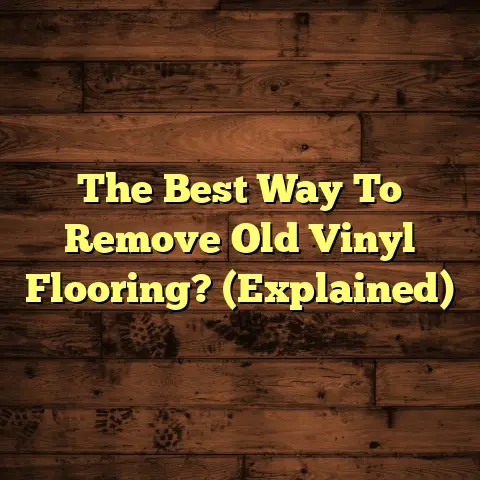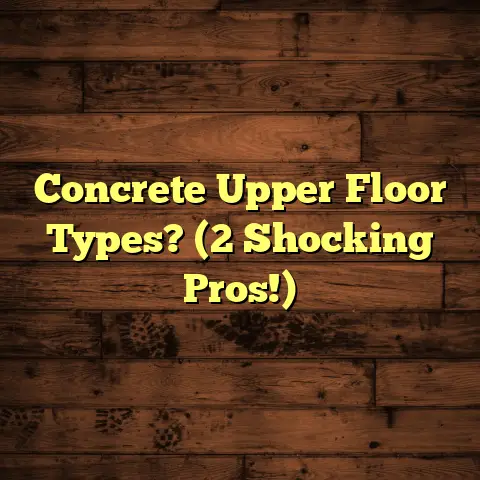Rubber Gym Flooring Mats Over Carpets: Pros And Cons?
I’m a flooring contractor, and I’ve seen it all when it comes to home gyms – the good, the bad, and the downright ugly.
Lately, I’ve been getting a lot of questions about rubber gym flooring mats over carpets.
It’s a hot topic, and for good reason.
We’re all trying to blend our love for fitness with the comfort and style of our homes.
So, can you really throw some rubber mats over that plush carpet and call it a day?
Well, buckle up, because we’re diving deep into the pros and cons of this flooring combo.
Section 1: Understanding Rubber Gym Flooring Mats
Definition and Composition
Alright, let’s start with the basics.
What exactly are rubber gym flooring mats?
Simply put, they’re durable, resilient surfaces designed to withstand the rigors of workouts.
Think of them as a protective shield for your floors (and your joints!).
Now, what are they made of?
You’ll typically find two main types:
-
Natural Rubber: Made from latex harvested from rubber trees. It’s eco-friendly but can be pricier.
-
Synthetic Rubber: Usually made from recycled tires (score for sustainability!) or other petroleum-based materials. It’s often more affordable and resistant to wear.
Within these categories, you’ll find different types of mats:
-
Interlocking Tiles: These are like giant puzzle pieces. Easy to install and customize.
-
Rolled Mats: These come in long rolls, perfect for covering larger areas. I find that these are best for wall-to-wall coverage.
-
Rubber Sheets: Similar to rolled mats but often thinner and more flexible.
Common Uses
I see these mats everywhere.
From commercial gyms to cozy home workout corners, they’re a staple for a reason.
Their primary job?
Protecting your subfloor from weights, equipment, and impact.
But they also provide a safe, non-slip surface for your workouts.
Think about it: Deadlifts on hardwood? Ouch. Jumping jacks on tile? No thanks.
Rubber mats offer that cushion and grip you need to push yourself without risking injury or damage to your home.
Section 2: The Appeal of Carpeting in Home Gyms
Aesthetic Qualities
Okay, let’s be real. Carpet is cozy.
It adds warmth and comfort to a room, making it feel inviting.
In a home gym, carpet can soften the sterile, utilitarian vibe that some workout spaces can have.
Plus, there are so many styles, colors, and textures to choose from.
You can really personalize your gym to match your existing decor.
I’ve seen some beautiful home gyms with plush, patterned carpets that make you want to do yoga just by looking at them.
Sound Absorption
One of the biggest reasons people choose carpet, especially in multi-use spaces, is its sound-dampening ability.
Dropping weights, blasting music, or even just heavy breathing can create a lot of noise.
Carpet absorbs some of that sound, making your workouts less disruptive to the rest of the household.
It’s a lifesaver if you live in an apartment or have kids who nap during your workout time.
Section 3: Pros of Using Rubber Gym Flooring Mats Over Carpets
So, what happens when you combine these two flooring titans?
What are the benefits of adding rubber mats on top of carpet?
Let’s get into it.
Enhanced Traction and Safety
This is a big one.
Carpet, especially plush carpet, can be slippery.
Try doing burpees on a shag rug – I dare you!
Rubber mats provide a much better grip, reducing the risk of slips and falls.
This is especially important for high-intensity workouts or exercises that involve jumping or quick movements.
I always tell my clients: “Safety first, gains second!”
Durability and Longevity
Carpet is not exactly known for being able to stand up to heavy abuse.
Weights, equipment, sweat, and dirt can quickly take their toll.
Rubber mats, on the other hand, are built to last.
They can withstand heavy impact, resist wear and tear, and protect your carpet from damage.
Think of them as a shield against the chaos of your workouts.
Ease of Maintenance
Let’s face it: Cleaning carpet is a pain.
Stains, odors, and embedded dirt are all too common, especially in a gym setting.
Rubber mats are much easier to clean.
A simple wipe-down with a damp cloth or mild detergent is usually all it takes.
No more endless scrubbing or expensive professional cleanings!
Shock Absorption
Rubber has natural shock-absorbing properties.
This is great for protecting your joints during high-impact exercises.
Think about jumping, running in place, or even just walking around with heavy weights.
The rubber mats will cushion your steps and reduce the stress on your knees, ankles, and back.
Your body will thank you!
Versatility and Customization
Rubber mats come in a wide variety of designs, colors, and thicknesses.
This means you can customize your gym to fit your personal style and space.
Want a sleek, modern look?
Go for black interlocking tiles.
Prefer a pop of color?
Opt for brightly colored rolled mats.
You can even find mats with different textures and patterns to add visual interest.
Section 4: Cons of Using Rubber Gym Flooring Mats Over Carpets
Okay, now for the not-so-fun part.
While there are definitely benefits to using rubber mats over carpet, there are also some drawbacks to consider.
Cost Considerations
Let’s be honest: Flooring can be expensive.
Adding rubber mats on top of carpet is an additional expense.
You need to factor in the cost of the mats themselves, as well as any installation costs (if you’re not doing it yourself).
It’s important to compare the cost of this option to other flooring solutions, such as removing the carpet altogether and installing a dedicated gym floor.
Potential for Odor
One of the biggest complaints I hear about rubber mats is the smell.
New rubber mats, especially those made from recycled materials, can have a strong odor.
This odor can be exacerbated in a carpeted environment, as the carpet can trap and amplify the smell.
The smell usually fades over time, but it can be quite noticeable at first.
Make sure to properly air out your space and consider using odor-absorbing products if the smell bothers you.
Installation Challenges
Installing rubber mats over carpet isn’t always a walk in the park.
The carpet can create an uneven surface, making it difficult to get the mats to lie flat.
This can lead to tripping hazards or movement of the mats during workouts.
You may need to use shims or leveling compounds to create a more even surface.
Limited Aesthetic Cohesion
While you can find rubber mats in a variety of styles, they may not always blend seamlessly with your existing carpet.
The combination of carpet and rubber can sometimes look disjointed or mismatched.
This is especially true if you have a patterned or brightly colored carpet.
Consider the overall aesthetic of your space before committing to this flooring combination.
Weight and Bulkiness
Rubber mats are heavy.
Adding them to a carpeted floor can significantly increase the weight load on your subfloor.
This is especially important to consider if you live in a multi-level home.
Make sure your floor can handle the added weight, and consider consulting with a structural engineer if you have any concerns.
Section 5: Real-Life Experiences and Testimonials
Okay, enough from me.
Let’s hear from some real people who have actually tried this flooring combo.
Case Studies
I recently worked with a client, Sarah, who wanted to create a home gym in her spare bedroom.
She already had a plush, light-colored carpet in the room, and she didn’t want to replace it.
She was worried about damaging the carpet with her weights and equipment, so she decided to install interlocking rubber tiles over the carpet.
Initially, she was thrilled.
The mats provided excellent traction and protected her carpet.
However, she soon noticed a strong rubber smell that lingered in the room.
She tried airing out the space and using odor-absorbing sprays, but the smell persisted for several weeks.
Eventually, she decided to remove the carpet and install a dedicated rubber floor.
On the other hand, I have another client, Mark, who had a positive experience.
He had a low-pile, neutral-colored carpet in his basement gym.
He installed rolled rubber mats over the carpet to protect it from his weightlifting equipment.
He didn’t experience any odor issues, and the mats provided a comfortable and durable workout surface.
He was very happy with the results and said it was a cost-effective way to create a functional gym space.
Expert Opinions
I reached out to a few fitness professionals and interior designers to get their thoughts on this topic.
Here’s what they had to say:
-
Fitness Professional: “I often recommend rubber mats for home gyms, but I usually advise against putting them over carpet. The carpet can create an uneven surface and trap odors. It’s better to remove the carpet and install a dedicated gym floor.”
-
Interior Designer: “From an aesthetic perspective, rubber mats over carpet can be tricky. It can look disjointed and cheap. If you’re going to do it, make sure the mats are a neutral color and blend well with the carpet.”
Section 6: Conclusion
Alright, we’ve covered a lot of ground.
So, what’s the verdict?
Can you put rubber gym flooring mats over carpets?
The answer, as with most things, is: It depends.
There are definitely benefits to this flooring combination.
Rubber mats can provide enhanced traction, durability, and shock absorption, while also protecting your carpet.
However, there are also drawbacks to consider.
Cost, odor, installation challenges, and aesthetic concerns are all potential issues.
Ultimately, the decision of whether or not to use rubber mats over carpet depends on your specific needs, goals, and aesthetic preferences.
Consider your budget, the type of carpet you have, the intensity of your workouts, and your tolerance for odors.
Do your research, weigh the pros and cons, and make an informed decision that’s right for you.
Happy sweating!





